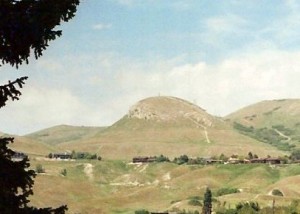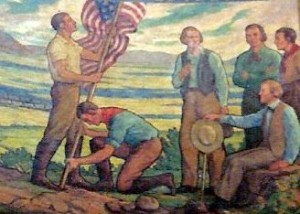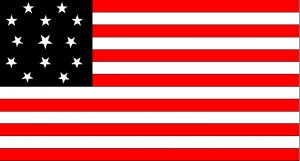Raising a Flag on Ensign Peak

Ensign Peak rises about one thousand feet above the valley floor. From its summit Brigham Young could survey the valley below.
More than a century and a half ago, Brigham Young and a group of Mormon Pioneers climbed to the top of an outcropping of rock to get a view of the Salt Lake Valley. The easily recognizable peak stands about one thousand feet above the valley floor, and Saturday, July 26th was the 166th anniversary of that excursion. Young declared the spot “a good place to raise and ensign” and so the mount received the name Ensign Peak. The name refers to a number of verses in the biblical book of Isaiah prophesying about raising an ensign in the latter days as a signal to gather “the outcasts of Israel.” These pioneers considered themselves to be these outcasts that Isaiah foretold would be gathered “in the tops of the mountains.” The ensign (pronounced en sine in Utah) referred to a flag raised as a signal. Many over the years have believed that the Mormon Pioneers raised a flag on that day of late July in 1847. “Reenactments” have taken place raising flags on Ensign Peak, and a painting in the drum of the rotunda of Utah’s State Capitol depicts this flag raising.

An artist depicted Brigham Young and his group raising a U.S. flag on Ensign Peak when they first climbed the bald outcropping of rock. While a flag raising did not take place then, it did happen later.
Nevertheless, historians agree that the small group climbing Ensign Peak on the 26th did not have a flag with them to raise. The historical evidence indicates that Brigham Young’s vanguard company of pioneers did not have a flag with them as they entered the Salt Lake Valley. However, the Pueblo Detachment of the Mormon Battalion entered the settlement a few days later on 29 July 1847, and George A. Smith later reported that the men marched into the valley carrying the U.S. flag. A member of the detachment reported that he was with a group that took the U.S. flag to the top of ensign peak after their arrival. So, although no flag was raised on Ensign Peak when the Pioneers first climbed and named it, a United States flag was flung to the breeze atop the peak soon thereafter.

According to a tradition of Brigham Young’s descendants, the flag raised on Ensign Peak may have looked like this flag.
